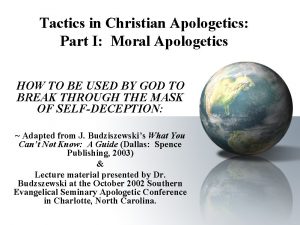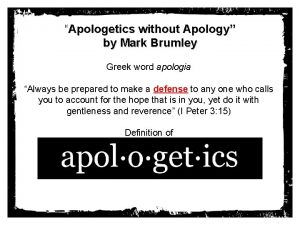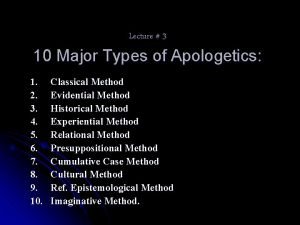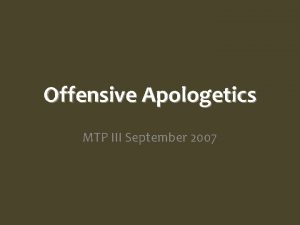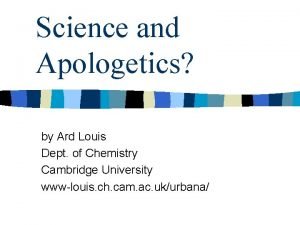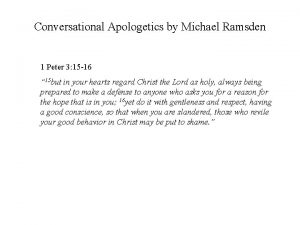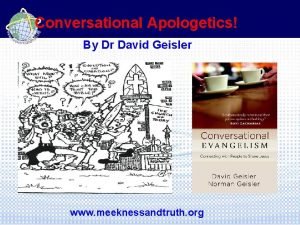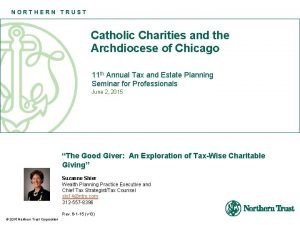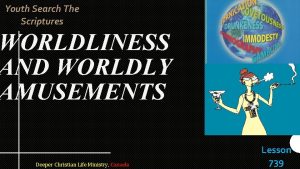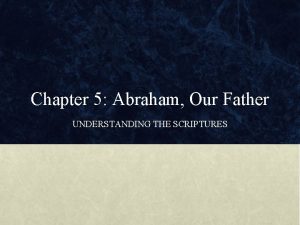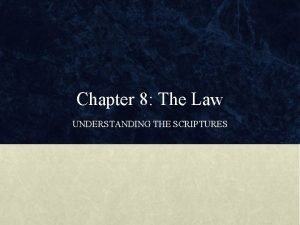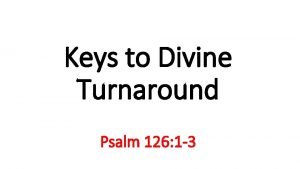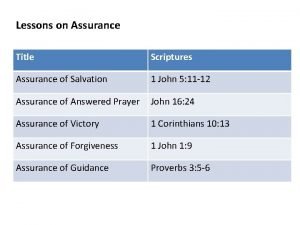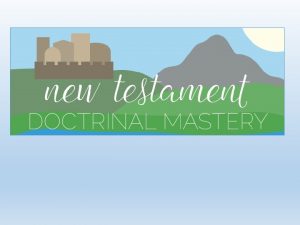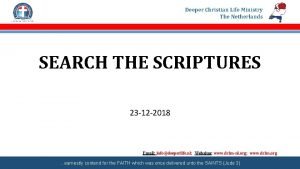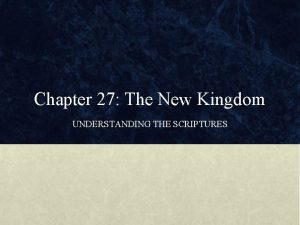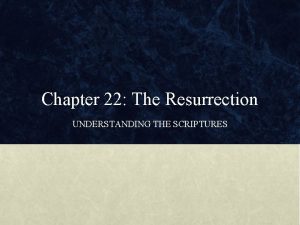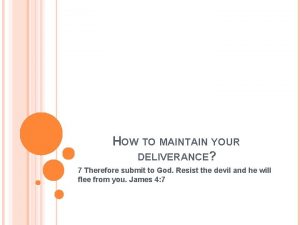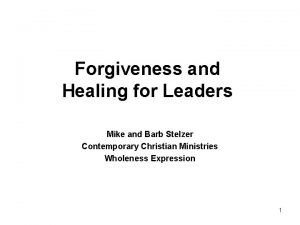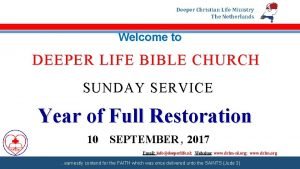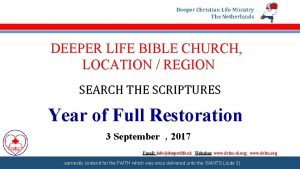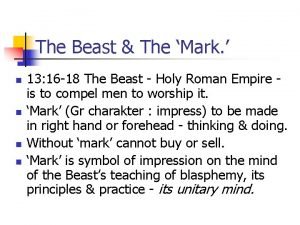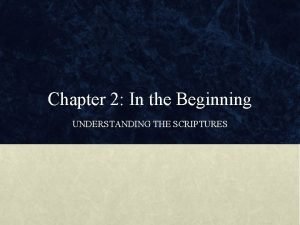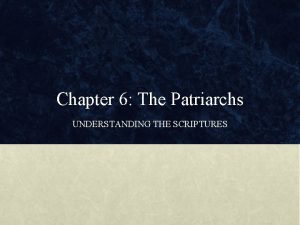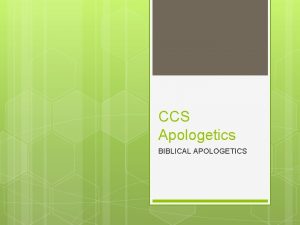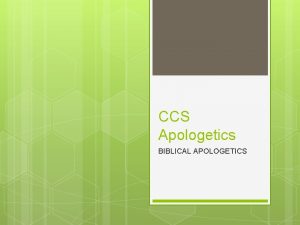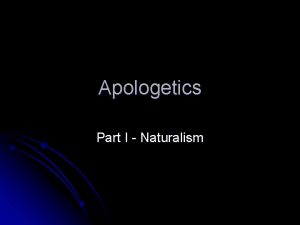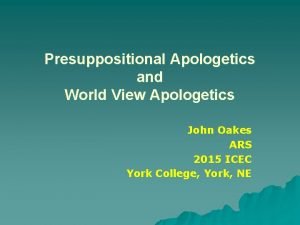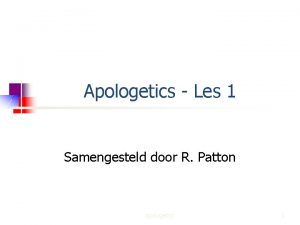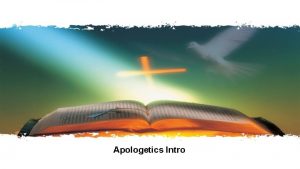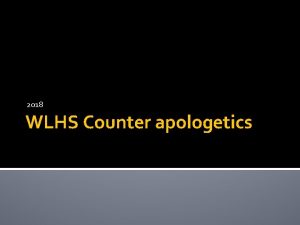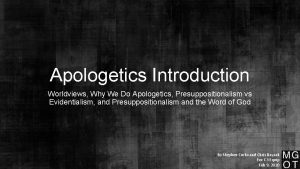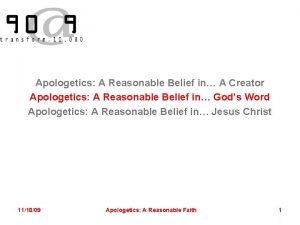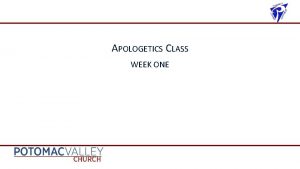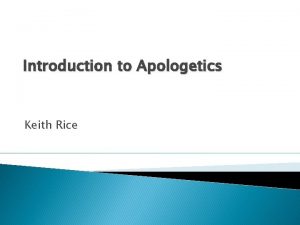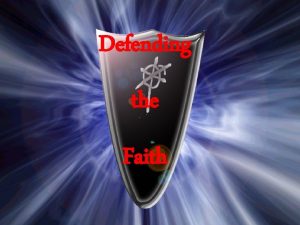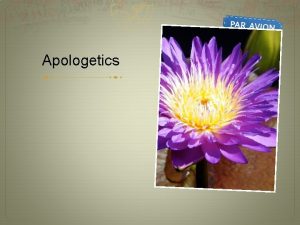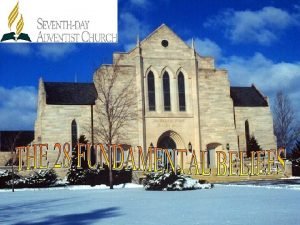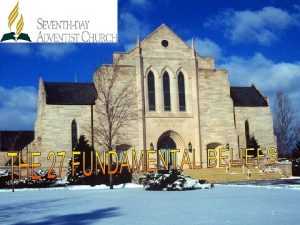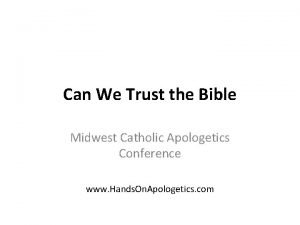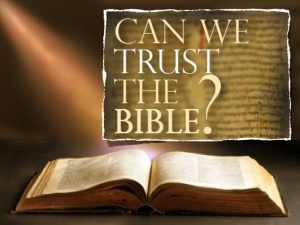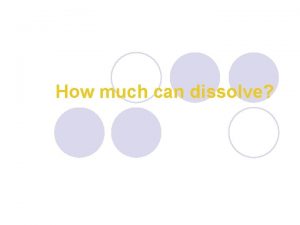How much can we trust the Scriptures Apologetics





























- Slides: 29

How much can we trust the Scriptures? Apologetics in Manchester 8 th May, 2010 Brenda Lewis

Introduction �Ravi Zacharias: �‘the Christian message stands or falls upon the authenticity or spuriousness of the Bible. ’ �Richard Dawkins says: �‘Much of the Bible is not systematically evil but just plain weird, as you would expect of a chaotically cobbled-together anthology of disjointed documents, composed, revised, translated, distorted and ‘improved’ by hundreds of anonymous authors, editors and copyists, unknown to us and mostly unknown to each other, spanning nine centuries. ’

Assessing the Evidence �M - Manuscript evidence �A - Archaeological evidence �P - Prophecy �S – Statistical Probability Hank Hanegraaff

Manuscript Evidence �Bibliographical �Internal evidence �External evidence

Bibliographical evidence �How many copies do we have? �What is the time interval between the original and the copy? �How accurate has the copying been?

How many manuscripts have we? �NT: 24 970 manuscript portions � 10% of all Greek documents are bible documents �Secular: see the chart attached to the handout! �Bruce Metzger says: �‘The works of several ancient authors are preserved to us by the thinnest possible thread of transmission. . . in contrast. . . the textual critic of the NT is embarrassed by the wealth of his material. ’

Old Testament Manuscripts �We have very little, but what we have is good quality �The Dead Sea Scrolls contain a complete copy of all of Isaiah, dated to 125 BC � 95% same as Masoretic Text

What are these NT manuscripts? � Papyrii � a) John Rylands papyrus, earliest, 125 AD 5 verses of John. Manchester � b) Bodmer II – most of John. Switzerland � c) Chester Beatty – most of the NT � d) Bodmer p 14/15 – most of Luke and John �Parchments, earliest late 2 nd century �Codices – bound books, earliest beginning 2 nd century

Dead Sea Scrolls (1) �Written and collected by Essenes from 300 BC to 100 AD in monastery at the Dead Sea � 253 scrolls �Between 40 000 and 100 000 inscribed fragments � 2 copies of Isaiah �Whole copies of I Samuel and II Samuel �Hidden by Essenes from the Romans in 68 AD �Discovered by an Arab boy in 1947

Families of Translations �Alexandrian Egyptian. Includes translations into Coptic and Ethopian, Codex Vaticanus and Codex Sinaiticus Early, but some errors. Basis of modern translations. �Byzantine 90% of all mss, careful and accurate Underlies the KJV New Testament �Western Various, mostly derived, although includes Syriac Less weight given to most of its mss

External Evidence – Church Fathers � 32 000 citations of NT by church fathers before 325 AD �Clement and Ignatius (95 -115 AD) quote 15 NT books �Between them the fathers quote every verse, bar 20 �Eusebius refers to every book in the canon �They do not accept gnostic gospels and epistles

External: Early Translations �Many early translations over a wide area �Syriac �Armenian �Georgian �Arabic �Gothic �Coptic �Ethiopian �Anglo-Saxon

How accurately has it been transmitted? �NT: 97%-98% certain �No NT variant affects doctrine � 300 000 to 400 000 variants among the 24 000 mss - the NT only has 134 000 words! �Westcott and Hort say: ‘If you remove trivialities. . . the words. . . still subject to doubt hardly amount to more than a thousandth part of the NT. ’

Variants �Accidental typos �Deliberate fixes �Smoothing � 38 places in NT with 10 or more words changed: �End of Mark �No-one has I John 5: 7 -8 � 15 -20 verses missing from the Codices Vaticanus and Sinaiticus �Differences between Alexandrian and Byzantine translations account for 20% of all variants

Weighting given to variants �Earlier the better – usually �If a difficult reading has been retained – better �Smoothing is suspect �Byzantine mss generally seen as more accurate �Early attestations – e. g. cited in that form by church father

Different pages – same document? �Handwriting �Page layout �Punctuation �Provenance �Thickness of pen strokes �Colour of ink �Which sacred abbreviations?

Other tests �Manuscripts are regarded as more reliable if they are: �Personal letters or written to a small group �Unpolished �Include trivia/details

Internal Evidence �Nature of contradictions – some minor ones which suggest eyewitness accounts �Sufficient witnesses – NT has 9 writers, 6 of whom had witnessed the miracles and the resurrection �Truthful – risked damnation; persecuted, martyred �Prejudiced – nothing to gain, included material which did not reflect well on themselves or on Jesus

Eyewitness accounts 3 objections: � 1. Church lost interest in historicity of Jesus and invented freely � 2. Eyewitness accounts had no importance then � 3. They could not have remembered accurately the teaching of Jesus

Marks of the historicity of the gospels �Jesus’ sayings are poetic – easily remembered �They show a single mind �Jesus uses unique vocab and phrasing �He alone tells parables �Material has been translated from Aramaic �Includes material irrelevant to later church �Includes counter-productive material

How do we date the manuscripts? �Mass spectrometer carbon dating – e. g John Rylands �Sometimes dated or mentions dateable event �Handwriting �Scrolls versus Books �Papyrus versus parchment

Internal evidence – dating the gospels �In the past scholars dated all gospels after 70 AD �But �Acts was probably written before 61 AD �Luke wrote his gospel before he wrote Acts �He uses Matthew and Mark as sources �Mark is earlier than Matthew �Mark uses some earlier sources still – � almost back to the resurrection!

Dating material in Acts �Speeches in Acts 1 -12 originally in Aramaic �These speeches emphasise Jesus as Messiah, so must be spoken in Jewish context �Therefore this part of Acts cannot have been invented freely at the end of the first century by the Greekspeaking church �Preaching begins 7 weeks after the resurrection – bad inventing! – lacks dramatic impact

Confirmation from Secular Writers �Thallus – darkness at crucifixion �Jospehus – many people mentioned in the bible, the crucifixion under Pilate, resurrection, disciples �Tacitus – Christ put to death during the reign of Tiberius by Pilate. Christianity spread quickly to Rome �Pliny – Christians met once a week, sang to Christ as to a god, righteous living, probably communion �Babylonian. Talmud – Jesus hanged on eve of Passover after a six-week warning

Archaeological evidence which corroborates the NT �No evidence refutes the bible � 1000 s of finds support the bible, e. g: �Pool of Siloam (1897) �Pontius Pilate, Prefect of Judaea – inscription (1961) �Ossuary of Caiaphas (1990) �Pool of Bethesda 1995

The canon �Popular idea that powerful Roman Catholics kept out many other worthy manuscripts, and chose the canon to suit themselves in the 4 th century �But �Church fathers for 300 years had cited whole NT canon �They did not cite heretical documents as scripture �The canon was only confirmed at Hippo and Carthage �The apostles, as witnesses, were probably the real guardians of the NT material

Apocrypha �In the LXX �Repudiated by Jews at Council of Jamnia, 90 AD �Translated into the Vulgate by Jerome, but later he called it untrue and tried to suppress it �Augustine championed its acceptance at Carthage, 397 AD �Roman Catholics, using the Vulgate, accept it �In KJV bible of 1611, but not 1644 �C of E: useful for ‘example of life and instruction in manners, but are not a source of doctrine’.

Summary �Dawkins’ charge is unfounded �The bible was written by 40 writers, in 3 continents over more than 9 centuries �But �A single purpose, an overarching meaning �A mass of evidence that the bible has been transmitted accurately

Further Information from �Why Trust the Bible? Amy Orr-Ewing �What the Da Vinci Code Does Not Tell You – Michael Green �(New) Evidence That Demands a Verdict – Josh Mc. Dowell �Norman Geisler ppt – 12 Points that Prove Christianity is True – CD available from www. normgeisler. com �Bethinking. org. uk �Biblequery. org
 Moral apologetics
Moral apologetics Apologetics
Apologetics Types of apologetics
Types of apologetics Offensive apologetics
Offensive apologetics Apologetics
Apologetics Conversational apologetics michael ramsden
Conversational apologetics michael ramsden Conversational apologetics
Conversational apologetics Northern trust charitable trust
Northern trust charitable trust How much caffeine in a snickers bar
How much caffeine in a snickers bar To whom much is given much is required meaning
To whom much is given much is required meaning How much is too much plagiarism
How much is too much plagiarism Scriptures on worldliness
Scriptures on worldliness Understanding the scriptures chapter 5 study questions
Understanding the scriptures chapter 5 study questions Understanding the scriptures chapter 24 study questions
Understanding the scriptures chapter 24 study questions Netherlands
Netherlands Provoking divine turn around
Provoking divine turn around Assurance of salvation outline
Assurance of salvation outline Doctrinal mastery scriptures
Doctrinal mastery scriptures Search the scriptures netherlands
Search the scriptures netherlands The deeper christian life
The deeper christian life Grandchildren in hebrew
Grandchildren in hebrew Understanding the scriptures chapter 3 study questions
Understanding the scriptures chapter 3 study questions Understanding the scriptures chapter 22 study questions
Understanding the scriptures chapter 22 study questions How to maintain deliverance
How to maintain deliverance Scriptures on forgiveness
Scriptures on forgiveness Deeper life netherlands
Deeper life netherlands Deeper life netherlands
Deeper life netherlands Mark of the beast scriptures
Mark of the beast scriptures Understanding the scriptures chapter 2 study questions
Understanding the scriptures chapter 2 study questions Understanding the scriptures chapter 6 study questions
Understanding the scriptures chapter 6 study questions
